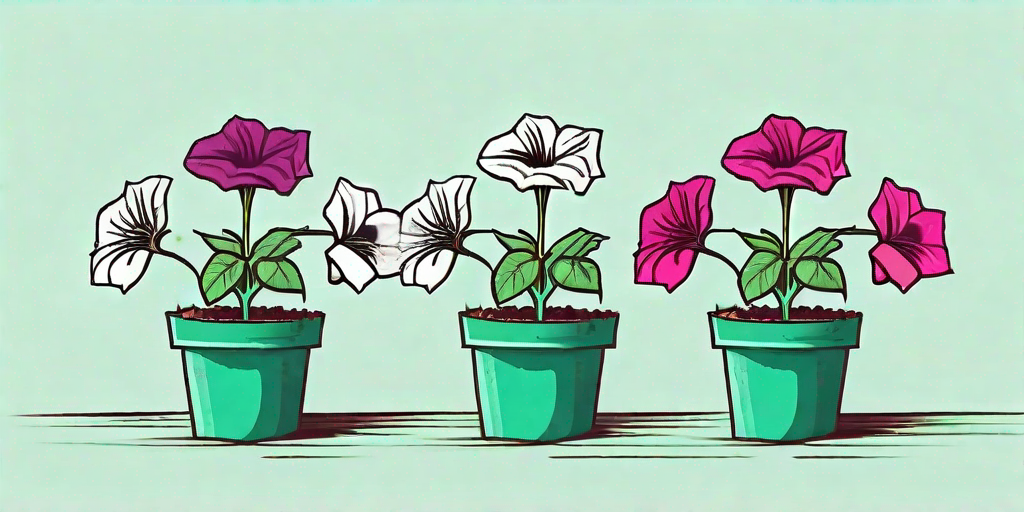
Petunias, the vibrant, trumpet-shaped flowers that grace many a garden with their presence, are a joy to behold. But have you ever wondered about the journey these beauties undertake, from tiny seeds to blooming wonders? Well, buckle up, because you're about to embark on a horticultural adventure that will reveal the secrets of successful petunia propagation.
The Life and Times of a Petunia Seed
Let's start at the very beginning (a very good place to start, as a certain musical taught us). A petunia seed is a tiny, unassuming thing, but within it lies the potential for a riot of color and beauty. It's like the shy kid in school who turns out to be a rock star. But how does this transformation occur? Let's find out.
Firstly, petunia seeds need the right conditions to germinate. This includes a warm temperature (around 70-85°F), moist soil, and a good amount of light. It's like a spa day for seeds, if you will. Once these conditions are met, the seed will begin to sprout, a process known as germination. This is the seed's equivalent of getting out of bed in the morning - a bit of a struggle, but necessary for growth.
Germination: The First Step
During germination, the seed absorbs water and swells up. This breaks the seed coat and allows the embryonic plant to emerge. It's like the hatching of a tiny, green chick. The first part of the plant to emerge is the root, which begins to absorb nutrients from the soil. This is followed by the shoot, which will eventually become the stem and leaves of the plant.
Germination is a critical stage in the life of a petunia seed, and it requires careful attention. Too much water can cause the seed to rot, while too little can prevent germination. It's a delicate balancing act, like trying to carry a tray of drinks through a crowded bar. But with a bit of care and patience, you can guide your petunia seeds through this stage and onto the next step of their journey.
From Seedling to Blooming Beauty
Once your petunia seeds have germinated, they'll begin to grow into seedlings. This is the equivalent of the awkward teenage phase, where the plant is still finding its feet (or roots, as the case may be). During this stage, the plant will develop its first true leaves, which are different from the seed leaves that initially emerged during germination.
As the seedling grows, it will require more light and nutrients. This is the plant's version of a growth spurt, and it's important to provide the right conditions to support this growth. This includes a well-draining soil, plenty of sunlight, and regular watering. It's like raising a child, but without the tantrums and messy bedrooms.
Transplanting: A New Home
Once the seedlings have developed a few sets of true leaves, they're ready to be transplanted into their final growing location. This is a big step for the little plants, like moving out of the family home and into their own place. But don't worry, they'll still need you to look after them.
When transplanting, it's important to handle the seedlings gently to avoid damaging the roots. It's also crucial to ensure the new location has good soil and plenty of light. After all, no one wants to move into a dingy, cramped apartment, do they?
The Blooming Stage: Showtime!
After all the hard work of germination, growth, and transplanting, it's finally time for the petunias to bloom. This is the plant's moment in the spotlight, the culmination of all its efforts. And boy, do they know how to put on a show!
Petunias produce a profusion of colorful, trumpet-shaped flowers that can brighten up any garden. They come in a range of colors, from white and pink to purple and red. It's like a fireworks display, but without the noise and smoke.
Maintenance: Keeping the Show Going
Once your petunias are blooming, it's important to maintain the right conditions to keep them healthy and vibrant. This includes regular watering, occasional feeding with a balanced fertilizer, and deadheading spent flowers to encourage new blooms. It's like being a stage manager, ensuring the show goes on without a hitch.
With the right care, your petunias can bloom throughout the summer and well into the fall. It's a long-lasting performance that's sure to earn a standing ovation from anyone who sees it.
FAQs: Your Petunia Queries Answered
How long does it take for petunia seeds to germinate?
Typically, petunia seeds take about 5-15 days to germinate. It's a bit like waiting for a kettle to boil - it seems to take forever, but it's worth the wait.
When should I transplant my petunia seedlings?
Petunia seedlings should be transplanted once they've developed a few sets of true leaves. This usually occurs about 6-8 weeks after sowing. It's like waiting for a cake to rise - you don't want to take it out of the oven too soon.
How often should I water my petunias?
Petunias prefer a moderately moist soil, so you should water them whenever the top inch of soil feels dry. It's a bit like making a cup of tea - you don't want it to be too weak or too strong.
Conclusion: The Joy of Petunia Propagation
From tiny seeds to blooming beauties, the journey of a petunia is a fascinating one. With a bit of knowledge, patience, and care, you can successfully propagate your own petunias and enjoy their vibrant display in your garden.
So why not give it a try? After all, as the saying goes, from tiny seeds grow mighty trees. Or in this case, blooming beauties.















